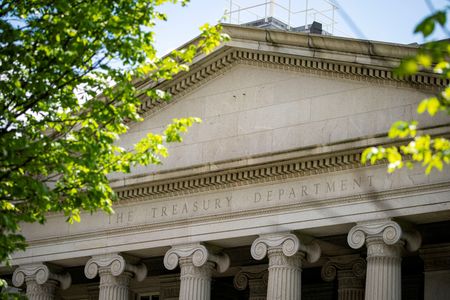By Davide Barbuscia
NEW YORK (Reuters) – Investors are bracing for a flood of U.S. government debt issuance that over time could dwarf an expected rally in bonds, as they see no end in sight for large fiscal deficits ahead of this year’s presidential election.
While bond markets so far this year have been driven mostly by bets on how deeply the Federal Reserve will be able to cut interest rates, fiscal concerns are expected to become more prominent as the Nov. 5 election nears. Analysts and investors say a reduction in deficit spending does not appear to be a policy priority for President Joe Biden and Republican challenger Donald Trump. Both candidates’ teams dispute this notion.
Some investors have already started to allocate funds in ways that would avoid losses if Treasury yields, which move inversely to prices, start surging because of supply and demand imbalances. Others are concerned that uncertainty over just how much debt will be needed for deficit spending could end up destabilizing the $27 trillion Treasury market, the bedrock of the global financial system.
“If we take a step back away from the Fed and away from the next six months where we could still get substantial rate cuts, supply numbers are not healthy,” said Ella Hoxha, head of fixed income at Newton Investment Management, who favors short-term maturities in Treasuries.
Benchmark 10-year Treasury yields, now at around 4.4%, could go up to 8%-10% over the next several years, she said. “Longer term, it’s not sustainable.”
So-called bond vigilantes – investors who punish profligate governments by selling their bonds – made a comeback last year, pushing 10-year Treasury yields to 5% for the first time in 16 years, but concerns over growing U.S. debt issuance subsided after the Treasury Department in November slowed down the pace of increases.
In its latest refunding announcement this month, the Treasury Department said it plans to keep auction sizes steady over the next several quarters. Still, larger auctions for long-dated debt are expected already next year, analysts have said.
Federal debt held by the public could grow by $21 trillion to $48 trillion by 2034, according to the Congressional Budget Office. Meanwhile, traditional sources of demand for U.S. government bonds are lagging. Foreign ownership is not keeping up with the growing size of the market and the Fed keeps shrinking its bond holdings.
“One of the things we’ve been talking a lot about internally is not just the supply but the demand,” said David Rogal, managing director and a member of the multi-sector team in BlackRock’s global fixed income group.
“An environment where you have a reduced buyer base and more supply definitely makes me think that over time you will see more term premium,” he said, referring to a measure of the extra compensation investors demand for lending to the government over the long term.
Democrats as well as Republicans have vowed to reduce deficit spending and debt levels.
“After the prior administration increased the debt by a record $8 trillion and didn’t sign a single law to reduce the deficit, President Biden has signed $1 trillion of deficit reduction into law and has a plan to lower the deficit by $3 trillion more,” White House spokesperson Jeremy Edwards said.
Anna Kelly, spokesperson for the Republican National Committee, said Trump’s “pro-growth, anti-inflation economic policies will … bring down interest rates, shrink deficits, and lower long-term debt levels.”
‘PROBLEM FOR TOMORROW’
A sudden drop in demand for U.S. government bonds is unlikely given the dollar’s leading reserve currency status and the size and depth of the Treasuries market.
“The most predictable crisis in history … is for the moment more a silent crisis,” JPMorgan analysts said in a recent note. “A problem ‘for tomorrow’ but not right now,” they wrote.
Still, some market participants have started to take stock.
Investor pressure on the Treasury Department to become more fiscally conservative would manifest itself with higher long-term yields relative to shorter-term ones, said Jonathan Duensing, head of U.S. fixed income at Amundi US.
“We’re much more in the front end and intermediate part of the yield curve right now and prefer to stay away in general from the longer-duration part of the Treasury curve,” he said.
In a sign of weakening demand, over the past year 10-year Treasury auctions have seen investors demand a concession to buy the paper more frequently than in recent years. Meanwhile, the U.S. Treasury 10-year term premium briefly moved back into positive territory last month.
“Ahead of the elections you probably don’t want to be owning as much very long-dated U.S. Treasuries,” said Brij Khurana, a fixed income portfolio manager at Wellington Management.
Others echoed those concerns.
Craig Ellinger, head of Americas fixed income at UBS Asset Management, said short-term debt “seems like the safer place to be in case deficits do get out of control.”
Kathryn Rooney Vera, chief market strategist at StoneX, is positioning for a steeper yield curve partly because she anticipates large issuance will pressure long-term Treasuries.
“The answer is reducing spending, and neither side wants to do that,” she said.
(Reporting by Davide Barbuscia; editing by Megan Davies and Paul Simao)





